Even unicellular organisms live in communities, and often these communities are complex and evolving. This is obviously the case for multicellular plants and animals, in which genetically related cells cooperate to form the adult. It goes even further in social organisms (like humans). |
 |
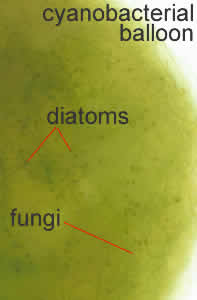 |
Biofilms: Communities of microbes will form on essentially any surface. Their properties influence how their component organisms respond to antibiotics and how they interact with each other and their host. The organisms within the biofilm secrete glue-like molecules that hold the film together (link: bacterial super-glue) The organisms within a particular community are often critically
dependent upon one another for nutrients, more to the point, their
behavior will be altered by their environment. ← Here is a micrograph of a community composed of bacteria, diatoms and fungi. The bacteria form a matrix in which the other organisms are embedded. |
| In fact, the vast majority of all microbes, have yet to be grown in monoculture. Even if it were possible, studying the properties of an organism in monoculture could be misleading, since interactions with other organisms can dramatically alter their behavior. The properties of a biofilm are not necessarily a simple function of its inhabitants. A biofilm is more than the sum of its parts. Biofilms mature over time. They have a natural progression, like a forest. |
| There is colonization, maturation and climax, each characterized by specific intrabiofilm and biofilm-host interactions. Not all of the organisms within a biofilm are necessarily "friendly" towards one another, and many antibiotics are the result of interfilm competition. |
|
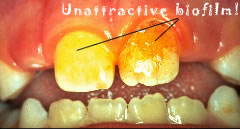 |
We live in close association with a number of biofilms. Their properties and dynamics, a topic that is beyond our scope here, play a critical role in health and disease. |
Making metazoans: Biofilms are communities or microecologies composed of distinct organisms living in various states of interdependence and competition. |
An early step on the path to true organismic multicellularity is the development of different cell types of the same organism. One example of multiple cell types is found in the bacteria Caulobacter crescentus. Under certain conditions it will produce stalk cells, that attached to a surface, and swimming cells that can migrate away and colonize new surfaces. In a sense, the stalk cell is sacrificing itself to form a swarming cell, that has a better chance at survival. |
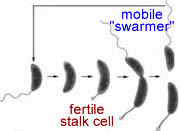 |
A higher level of integration occurs in the eukaryotic slime molds, in particular the cellular slime molds, such as Dictyostelium discoideum, which can form temporary multicellular organisms. Cellular slime molds live in soil and eat bacteria - they are predators. Most of the time they are small, amoeba-like, haploid cells. Upon starvation, however,
they undergo a dramatic aggregation process. |
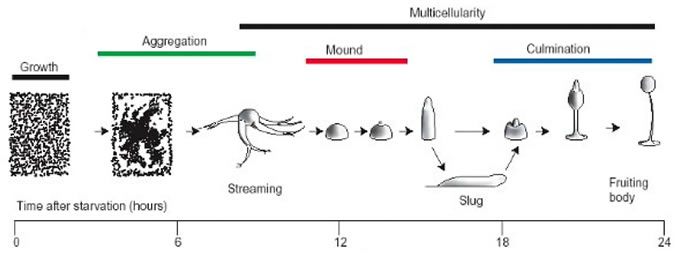
Aggregation is triggered by the release from isolated cells of pulses of cyclic adenosine monophosphate (cAMP). This leads to the streaming aggregation of cells towards the cAMP source. Between 10,000 to 100,000 amoebae aggregate but remain as distinct cells. They adhere to one another to form a slug. The slug can migrate and eventually will differentiate, forming a fruiting body that rises above the soil. |
|
Some of the cells of the slug differentiate to form the stalk. These cells are terminally differentiated and die without reproducing themselves. They sacrifice themselves for the good of the aggregate. Others form the fruiting body, which differentiates to form spores. When released, the spores can be widely dispersed and go on to form single celled amoebae. The slime molds are temporary metazoans. |
How is the "self-sacrificing" behavior of the stalk cells possible? The answer lies in inclusive fitness. The purpose of the slug and stalk are to enable Dictyostelium cells to escape a hostile environment and colonize new, hopefully more hospitable environments. Since Dictyostelium cells do not migrate far, most of the cells in any particular region, that is the cells that combine to form a slug, are likely to be closely related to one another - they are part of a clone. The sacrifice of stalk cells is more than made up for by the increased chance that the spore cells will survive and prosper, that is, from an evolutionary perspective, have lots of offspring. Of course there is a danger that some cells have diverged (through mutation), and will try to cheat, that is, avoid becoming stalk cells. Such cheating has been observed in wild type Dictyostelium [link][link], and cheating is a challenged faced by all multicellular systems. We deal with it more in the next reading. |
 |
In some cases, the cells are held together by a gelatinous matrix and form loose colonial groups. |
Alternatively, the cells can be more regularly organized, as in a Volvox. Volvox can reproduce asexually, by forming daughter colonies that develop within the mother. There is also a sexual cycle, mediated by the formation and fusion of gametes. These colonial organisms appear closely related to higher plants or metaphyta. |
 |
The animals or metazoa appear to have been derived from a different eukaryotic lineage. Their sister group (that is their closest unicellular relatives) appears to be the choanoflagellates. |
 |
Choanoflagellates have cells that are characterized by a single flagellum surrounded by a distinctive collar structure. Choanoflagellates exist in both unicellular and simple colonial forms. The collar cells are located on the periphery of the cellular aggregate, while amoeboid cells are located in the interior. |
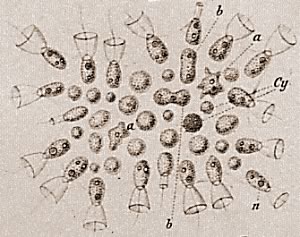 |
Sponges (porifera) are among the simplest of the metazoans. They contain only a few different types of cells. These include
|
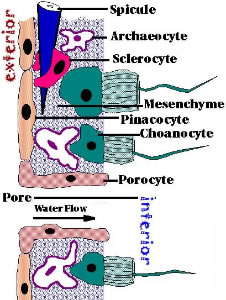 |
|
As fluid is pumped through the surface pores, particles of food are captured. Aside from these fluid movements, sponges are sessile, unmoving. Fossils of extinct sponges, such as the Archaeocyathids, are found in Cambrian rock that is over 500 million years old. Earlier sponge-like organisms, for example Paleophragmodictya have been found in Precambrian rock. PBS : THE FIRST ANIMALS |
The next level of metazoan complexity is represented by hydra and related organisms, the hydrozoa, which include the jellyfish. Some of these organisms alternate between a sessile and benthic or floating lifestyle. They can swim and can move in subtle ways. |
The hydrozoa contain more distinct cell types than the porifera. The most dramatic difference is their ability to produce coordinated organismic movement. While sponges are like sieves, the hydrozoa have a single distinct mouth and an internal stomach-like cavity, specialized to digest prey. Their mouth also serves as their anus, through which wastes are released. |
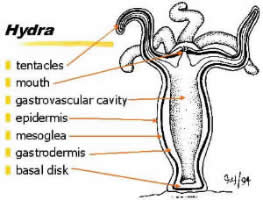 |
Hydrozoan movement is coordinated by a network of cells, known as a nerve net, that acts to regulate contractile muscle cells. Together the nerve net and muscles cells generate coordinated movements. There is no central brain, which in its simplest form is just a dense mass of nerve cells. Nevertheless, a hydra can display movements complicated enough to capture and engulf small fish! |
 |
 |
|
Stinging cells, nematocysts, are located in the "arms". Triggered by touch, they explode outward, embedding themselves in prey and delivering a paralyzing poison. Hydrozoans are complex enough to be true predators. |
Questions to answer
|
|
Questions to ponder |
|
| replace with revised beSocratic activity |
| Tweet | revised
10-May-2014
|